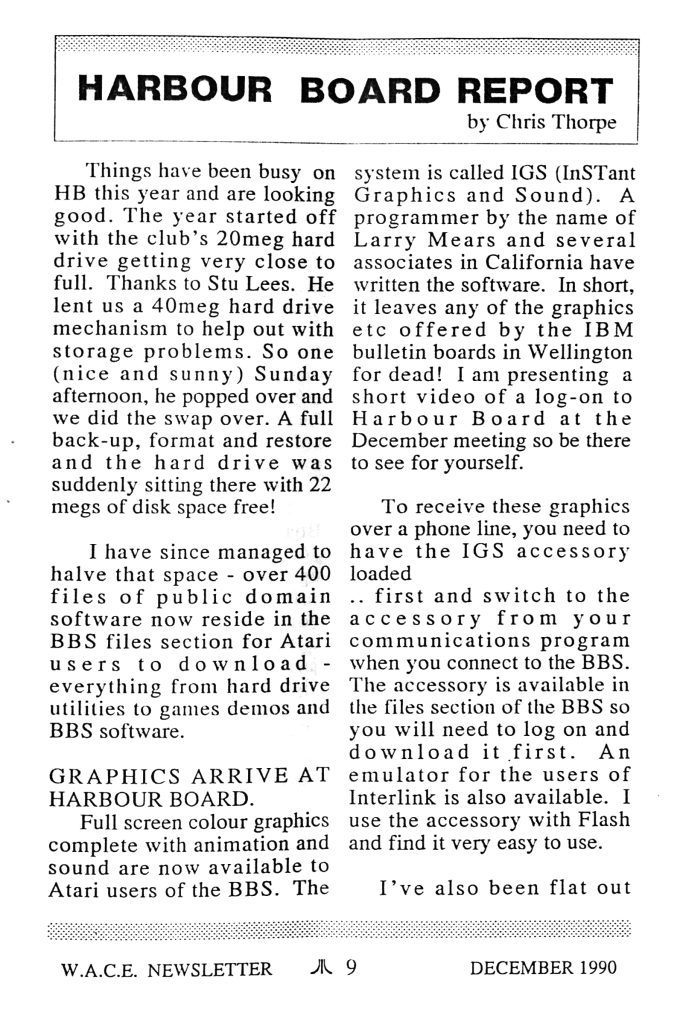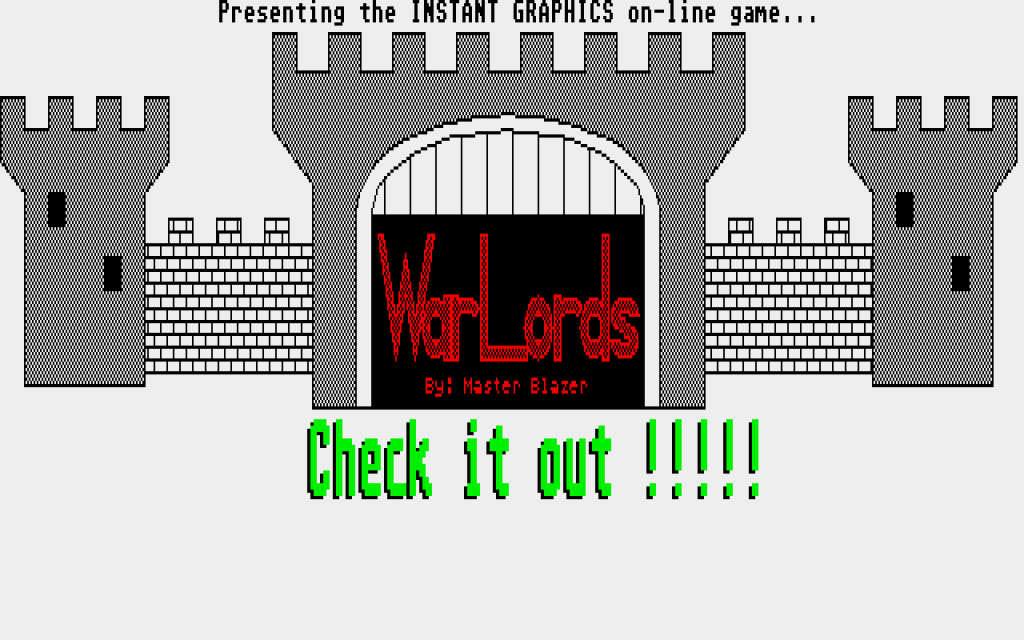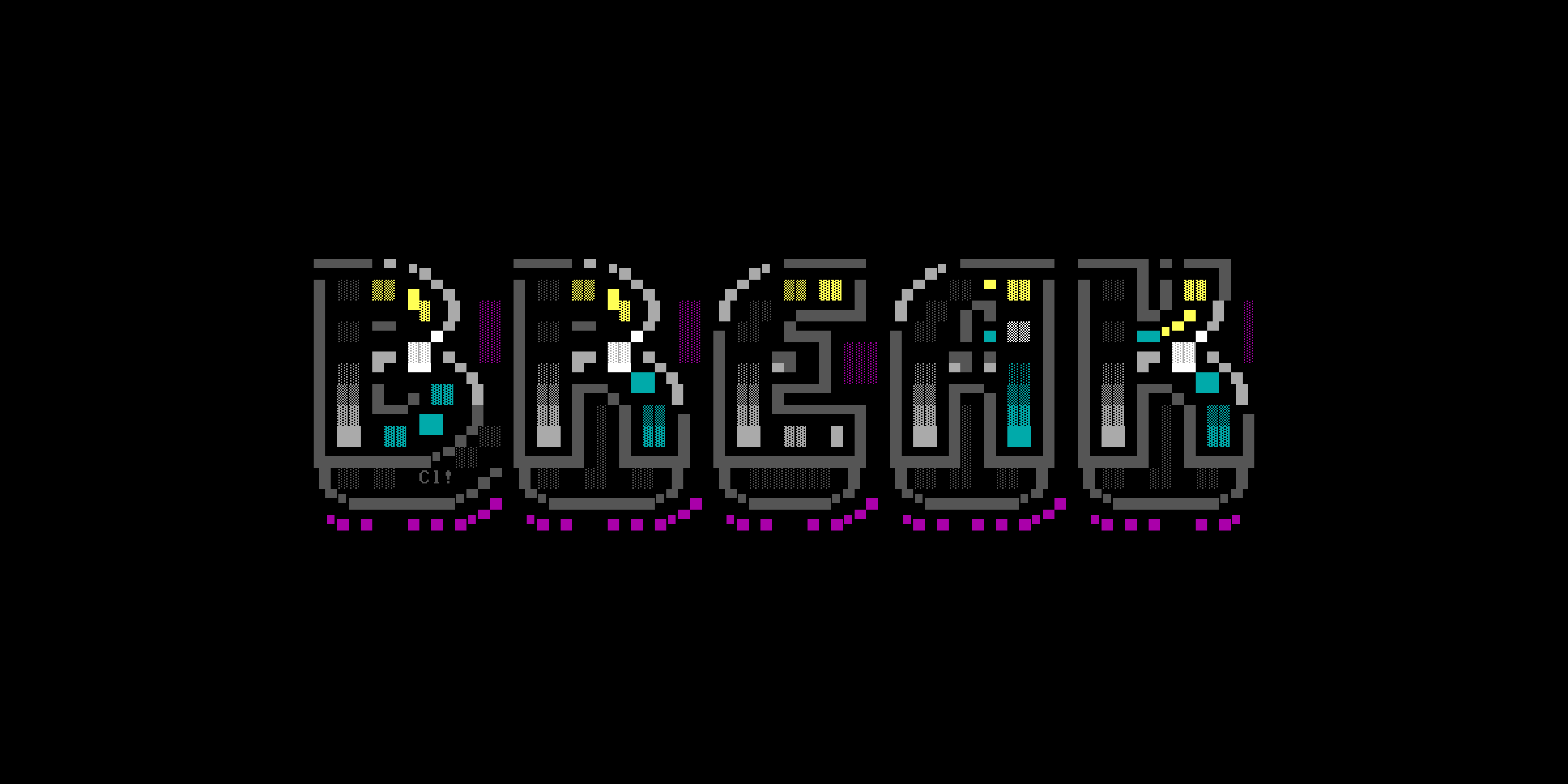This is the fifth part of a multi-part series.
Thirty hours into his “world tour,” Jon Clarke was discombobulated.
His business trip had begun on July 19, 1991, with a scary false alarm: during takeoff from his hometown of Auckland, New Zealand, the oxygen masks had suddenly deployed. He spent much of the rest of the flight fiercely defending his beloved Atari ST from the Mac and PC fans seated around him. And then the masks deployed again!

When he debarked the plane in Hawaii to make his first connection, he was blasted by hot, humid air. He had changed seasons, leaving behind winter in Auckland and arriving to summer north of the equator.
But now, after long connecting flights, Clarke finally had arrived at the Newark airport. Ron Kovacs, one of several online Atari friends Clarke would visit on the trip, was waiting to pick him up. Kovacs was the publisher of Z*NET online magazine, where Clarke, the co-sysop of “STaTus BBS” in Auckland, was a contributing writer.
Kovacs planned to take Clarke to his hotel, then give him a driving tour of New York. A jet-lagged Clarke loaded his luggage into Kovacs’ car, then walked to the driver’s side, opened the door, and prepared to hop in. “You going to drive as well?” asked Kovacs, bemused. Slowly, realization dawned on Clarke: Americans drive on the opposite side of the road from New Zealanders. It was a head-slapping moment.
After some sight-seeing, Clarke’s wits returned. Eventually, Kovacs brought Clarke to “Z*NET Headquarters” — his home in New Jersey. Kovacs showed off his BBS setup, an Atari Mega ST with plenty of hard disks and a new v.32 modem.
Then Clarke decided to turn the tables and show Kovacs something unbelievable: Clarke’s own “STaTus BBS” in New Zealand had a mouse-driven, point-and-click graphical user interface.
“When I told Ron you can log onto our BBS and see a GEM desktop rather than plain old ASCII, he had to see it,” Clarke recounted in the first two parts of an entertaining travelogue he wrote later for Z*NET.
Clarke installed the “Instant Graphics and Sound” software onto Kovacs’ computer, then dialed in to STaTus BBS. Never mind the international long-distance charges!
“IGS_DEMO.IGS” is an animated demonstration of the GEM-like graphical user interface created by Stu Lees and Jon Clarke for their bulletin board system, STaTus BBS in New Zealand.
Seeing a GEM-like desktop appear, with a menu bar, drive icons, and clickable windows was mind-blowing. Kovacs was lucky to get a one-time, in-person demonstration of this ambitious, one-of-a-kind setup. There was nothing else like it in the online Atari world.
IGS, the plain-text protocol that made all this possible, had begun taking off in New Zealand in late 1990, according to old issues of the Wellington Atari Computer Enthusiasts (WACE) newsletter, when sysop Chris Thorpe added IGS support to his “Harbor Board” BBS. He was stoked about it.

“In short, it leaves any of the graphics, etc. offered by the IBM bulletin boards in Wellington for dead!” he wrote in the December 1990 issue of the WACE newsletter.
A couple months later, and a few hundred miles to the north in Auckland, Jon Clarke and and his co-sysop Stu Lees debuted their IGS-powered graphical user interface for “STaTus BBS.” They promised that all Atari users who tried it would “see and hear a new world of modeming,” in an article in the February 1991 issue of the WACE newsletter.
Clarke and Lee’s innovative interface used IGS to transmit the graphics and visuals, but the logic was implemented in MCL, a scripting language included with the MichTron BBS software. Their system saved each users’ desktop layout and remembered it for future sessions.
For everyone else who couldn’t afford to make phone calls to New Zealand, Clarke and Lees created a standalone animated demonstration of the monochrome version of their GUI and uploaded it as “IGS_DEMO.IGS” in April 1991 to the GEnie online service and other BBS networks. Anyone could play this animation locally in the Instant Graphics desk accessory to get a small taste of the real experience.
Clarke and Lee’s GEM-like interface on STaTus BBS was a powerful example of the new experiences made possible by the mouse-interaction features that Larry Mears had added to “Instant Graphics and Sound” a year earlier, in May 1990, described briefly in my earlier post, Part 4: The Artist and the Community.
In this part of the series, we’ll take a closer look at sysops and artists’ attempts to add point-and-click functionality to their boards. We’ll look first at BBS menus, then explore three IGS-powered door games. Here are some quick links, if you want to skip ahead:
Do you enjoy my retrocomputing stories on Break Into Chat? Please join my email list and stay in touch. 📬
BBS MENUS
Menus were a cornerstone of the bulletin board system experience, since most functions required the user to press a key. Menus showed which keys would perform which functions — an important thing to know since there was little consistency in key assignments from board to board.
After Larry Mears released the first version of “Instant Graphics!” in 1988, it became possible for sysops to enhance their boards’ menus. As seen in Part 3 of this series, many of the early adopters of Instant Graphics weren’t skilled enough to draw fancy graphics. But most sysops using IG at least decorated their menus by changing fonts and colors, or adding backgrounds, boxes and borders.
For folks with some artistic ability, though, it was possible to do more. In Houston, Tom D’Ambrosio created a fun main menu for “KenCom BBS”, with several Star Trek-related icons placed near related menu items. For example, he put a TNG-style combadge icon near the “Chat” entry in the menu, and a sliding-door icon near the “Holodeck” entry.
Main menu of KenCom BBS, designed by Tom D’Ambrosio.
Still, even bulletin boards that decorated their menus with fancy Instant Graphics remained fundamentally keyboard-driven.
But then the first mouse-driven, point-and-click IGS menus appeared on “WRB BBS,” one of Larry Mears’ favorite bulletin boards in his hometown of Huntsville, Alabama. Mears created these menus himself to test his new IGS mouse functionality in May 1990. Many of the WRB menus were derived from a template consisting of a grid of large rectangular buttons. The system was simple and adaptable, but also somewhat plain and repetitive. Here’s an example of WRB’s “BBS functions” menu:
BBS functions menu on WRB BBS.
IGS had long enabled a whimsical approach to menus, like the “flying saucer” door game menu created by Steve Turnbull for “London Smog BBS” which we saw in Part 4 of this series. But the novelty of making menus with clickable buttons led some people to create downright bizarre designs (a phenomenon that would be repeated in the wild, woolly early days of the World Wide Web).
Case in point: this email menu template, which shipped in v4.99 of the “ST Keep” bulletin board software package around 1992, featured a large “E” made of four buttons:
But some people made better use of this medium. In 1993, an unknown artist in Houston, Texas, created a simple, clean, and stylish clickable main menu for “Skyline BBS.” Copies of Skyline’s menus were preserved by Tom D’Ambrosio, who used them as inspiration for his work customizing KenCom.
As a graphic designer for most of my career, this one gets a high grade from me. I love how it incorporates the board’s “skyline” theme effectively with an elegant use of gradients and negative space. The typography is well done, and the buttons are compact rather than garishly large.
DOOR GAMES
Beyond upgrading a BBS’s “interface” with clickable menus, IGS’ new mouse-interaction features had enormous potential for games.
“Knowing exactly where the cursor was pointing on the screen now meant that an online racing game, or a shooter game, or any type of ‘mouse/screen control’ game was now possible,” IGS enthusiast Steve Turnbull wrote years later.
Several people, including Turnbull, were inspired to try designing mouse-driven BBS door games. Three such games were released in 1990 and 1991.
WarLords
Released in September 1990, “Warlords” is a turn-based strategy game that requires four players. Each player begins the game with a castle and a number of troops. Over time they must manage resources and move troops to conquer other tiles and defeat opponents in combat. It’s similar to the board game RISK or the 1987 computer game “Empire: Wargame of the Century.”
WarLords was programmed by “Master Blazer” and “Weird Al,” two brothers who lived in the Toronto area and ran the “Stupid BBS.” I have been unable to trace the real identities behind these handles, but I’d love to hear from anyone who might know more.
Of the three IGS games, WarLords is perhaps the closest in spirit and execution to a traditional text-only BBS strategy game. The game’s screen consists of a compact 13×13 grid on the left, with game options and information on the right. Information about each tile of the grid is conveyed by letters and numbers rather than icons or artwork.
This video shows one of my recent sessions playing WarLords on StarFleet Headquarters BBS.
The game is deceptively simple. You can move your armies just three times per day, and the only resources you manage are money and troops — no complicated technology trees or production management. Besides castles, villages and towns, tiles can also be forests, lakes, or swamps, each of which has a different effect on combat or troop movement.
Players earn money simply by conquering populated tiles, then collecting taxes from them. Yet the game’s constraints and slow pace generate suspense and force you to carefully consider your strategy. Over a few months of playing on StarFleet HQ, the game kept growing on me.

Until very recently, this game was unavailable in any public archive. Andy Klenotic, sysop of the present-day “StarFleet HQ BBS,” had a personal copy and recently got the game back online. So far, I have found only one contemporary reference to it, a fleeting mention in a 1993 list of online games for FoReM/Turbo BBSes in Z*Net online magazine.
The game itself seems well-coded and fairly robust. There are thoughtful details, like the various ways the game populates the tile grid with information, ranging from diagonal wipes to spirals. The game includes an explicit “Redraw” function in case the game screen becomes corrupted by line noise or dropped data. During all the months I played WarLords, though, I never experienced any screen corruption. I only ran into such issues when playing the other two games.
In this video capture, I eliminate my final opponent and secure the victory in a game of WarLords.
My main criticism: the point-and-click feature is half-baked. You use the mouse only to select source and destination tiles when moving or placing troops. All other game actions and options are controlled by the keyboard. It’s awkward having to switch back and forth.
The limit of three turns a day is frustrating from a modern perspective, but it was a common constraint in the resource-limited days of BBSing. Most boards could only allow one person at a time to use the system.
But at the end of the day, I found it to be an engaging game. I kept playing it for months until at last I defeated my final opponent (myself).
Star Battle
Kevin Moody of Jacksonville, Florida, who had co-created the IGS Editor with Anthony Rau, also produced a Star Trek-themed BBS door game called “Star Battle,” which he released in October 1990.
Star Battle was Moody’s first foray into game development. He relied heavily on his editor to draw the game’s interface and graphics. He wrote the game in C, and included the source code in the shareware release, hoping to encourage others in the Instant Graphics community to use the protocol to make cool stuff.
“Hopefully some of you programmers can decipher what I’ve done in the code I’ve included and come up with your own ideas,” he wrote.
This video shows one of my recent sessions playing Star Battle on Dark Force BBS.
The v1.02 release of Star Battle, which included binaries as well as source code, was preserved in two CD-ROM collections, but I have been unable to find any contemporary reviews, discussions, or mentions of it. Ronald Hall, sysop of the present-day “Dark Force BBS”, installed the game recently and we both tried it.
There are definitely differences between the binary and the source. For example, I extracted the IGS code for the title sequence from the source. It’s impressive: an American flag scrolls up the screen with the game’s name and credits, followed by a rendition of the Star Trek fanfare. But only the music appears in the binary version — either the program is broken, or the flag animation was omitted.
This video shows the extended title sequence I extracted from the source code.
Beyond that, though, both Hall and I found the game rough and difficult to play. Neither the “HOW.TO” text file nor clicking “Help” in the game itself make it clear what you’re supposed to do. Worse, the mouse hot spots can get misaligned easily, breaking the point-and-click functionality.
During a couple attempts to play, I somehow managed to get into a firefight with a Romulan ship. During this sequence, a visual of the enemy appeared on the viewscreen, which was cool to see. As we traded shots, the screen pulsed red each time a hit landed, via palette-cycling effects. But I couldn’t tell who was winning or losing the battle. The buttons labeled “phasers” and “torpedoes” both seemed to do the same thing. Worse, clicking two other unlabeled buttons also did the same thing!
All in all, Star Battle feels to me like a game that had potential, but sorely needed more playtesting and feedback.
Crapz!
One year after Star Battle debuted, Steve Turnbull delivered an impressive and far more visually polished point-and-click game: “Crapz!”, a colorful IGS implementation of the popular dice game.
Like Moody, Turnbull had never written a game before, but as one of IGS’ biggest supporters, he felt motivated to make a project that could showcase its mouse features. But, unlike Moody, Turnbull had extensive professional experience as an artist; and since discovering “Instant Graphics!” in early 1990, he had become a master of creating animated graphics in the sometimes inscrutable IGS format.
The simplicity of craps made it an ideal project for a novice programmer, allowing Turnbull to focus on the presentational aspects of the game, rather than sweating the logic.
This video shows one of my recent sessions playing Crapz! on Dark Force BBS.
“Since this program was merely a ‘test bed’ project to see if some ideas might actually work, CRAPZ! was not written with brilliant gameplay in mind,” Turnbull wrote in the game’s documentation.
He published the game as shareware under the banner “Light Headed Software” and asked users to send in $10 to register.
The final result is vintage Turnbull: a groovy moiré background created by looped line-draw commands, elegant typography with text shadows, animation, actions punctuated with sound effects, and color cycling effects.
Recently, Ronald Hall installed Crapz! on his Dark Force BBS so we could both try it.
In my experience, Crapz! was far more stable than Star Battle, though I did experience a few minor glitches in some play sessions. More importantly, it’s a fun game to play, and far more attractive and engaging than most of the ASCII and ANSI dice games that were created for BBSes throughout the 1990s.
VAPORWARE
Every good platform has projects that never saw the light of day, and IGS was no different. I have found several instances of people who announced their intention to make something, such as Chris Thorpe, the sysop of Harbor Board BBS in Wellington, New Zealand, who said in a WACE newsletter that he hoped to add IGS support to the existing game “Conquest.”
But some authors made it much further than the idea phase. Here are two examples of unfinished IGS games:
Wildcardz!
After releasing Crapz!, Steve Turnbull spent four months in 1992 working on a sequel — a high-speed poker game he called “Wildcardz!”
He described the game as his “magnum opus” years later when he wrote an IGS retrospective, adding:
“It was a new game that really strutted IG’s stuff. A fully detailed deck of 52 cards could be smoothly fanned across the screen in seconds, while gameplay reproduced an animated poker table game — chip stacks and all! It produced the graphics on the remote player’s screen, not by sending pre-coded chunks of graphic commands, but by creating and assembling the IG code on-the-fly in response to the user’s mouse clicks and mouse movements.”
It’s unclear if Wildcardz! was finished, but it sounds like it was pretty far along. Regardless, as far as I can tell, it was unpublished and unarchived. No screenshots, IGS art, or anything else related to it has survived.
Galaxy I.C.E.
The situation is different with “Galaxy I.C.E.”, a sci-fi strategy game being developed by a team in Houston including Tom D’Ambrosio, Kenneth Miller, Matt Potter, and Kim Nevelsteen.
The authors ambitiously planned for the game to support two different graphics protocols: IGS for the Atari ST, and Tom Hunt’s Color Graphics System (CGS) for Atari 8-bit computers. The “I.C.E.” acronym, which stands for “IGS / CGS Extension,” is a nod to this. Curiously, though, they weren’t developing the game for ST BBSes — it would only run on 8-bit Atari boards using the “BBS Express” software.
They created an animated demo of the game which users could view using the Instant Graphics and Sound desk accessory, to give an early preview. The demo was “intended only to provide you with an idea of what the final game might look like,” they warned. “The final product might appear much different.”
Tom D’Ambrosio recently recovered a copy of this demo from his old Atari disks and sent it to me.
This video shows “GALAXY.IGS”, an early preview of the game “Galaxy I.C.E.”
Watching the demo today, I can understand their warning. The graphics are very limited: just an animated title screen, a screen with a few icons, and a map grid. Everything else shown is plain text, very similar to classic BBS door games like “Space Empire Elite” or “TradeWars.”
The game was never finished or released, but there’s some hope it could be resurrected. For 30 years, D’Ambrosio has kept a SCSI hard drive which contains the game’s source code and development files. After all that time, though, the drive has some issues, so we’re exploring recovery options.
Up next — Part 6: Legacy

Share your thoughts!